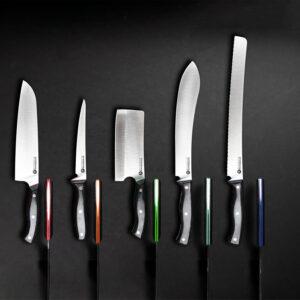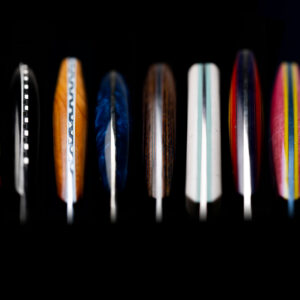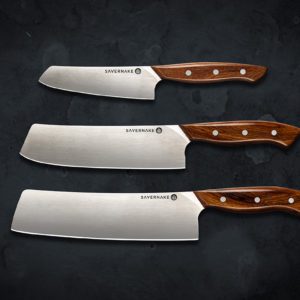CARING FOR YOUR SAVERNAKE KNIFE
The best way to look after your knife is to hone it every time you use it, thereby having to sharpen only occasionally. Our knives are made to be as hard as possible while still being able to take a good honing.
Understanding the difference between honing and sharpening is the single most important thing you can learn (as regards caring for a knife). A good honing steel, such as our own range (with the ability to match the handle to your knife) is vital, and you should use it gently every time you cook, if possible – watch our video to find out how.
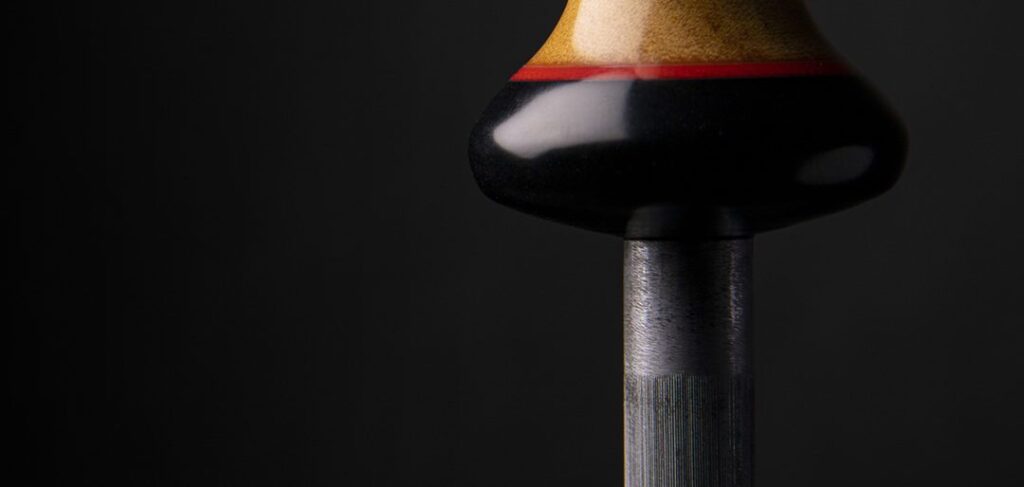
Sharpening vs honing
Honing requires a decent honing rod and serves to reshape the very edge of a blade after it becomes misaligned through frequent and inconsistent contact with a chopping board. A professional chef will do this every time they cook. Far from the fast-paced, slashing technique that we often see on television (we’re looking at you Mr Ramsey), this should be done slowly and methodically. The key is to maintain the same angle, or as close as is humanly possible, as you slide the blade’s edge along the rod, alternating sides as you do so. The perfect angle will be dictated by the angle of the initial bevel made by the maker of the knife, but generally speaking, a chef’s knife will be somewhere between 17-22 degrees.
Regular honing will delay the need for sharpening, two terms which are often thought to mean the same thing. Sharpening will generally need to be done a couple of times a year, with a whetstone being the most effective method. This is a slightly more involved process with numerous online videos and tutorials showing how it’s done properly.
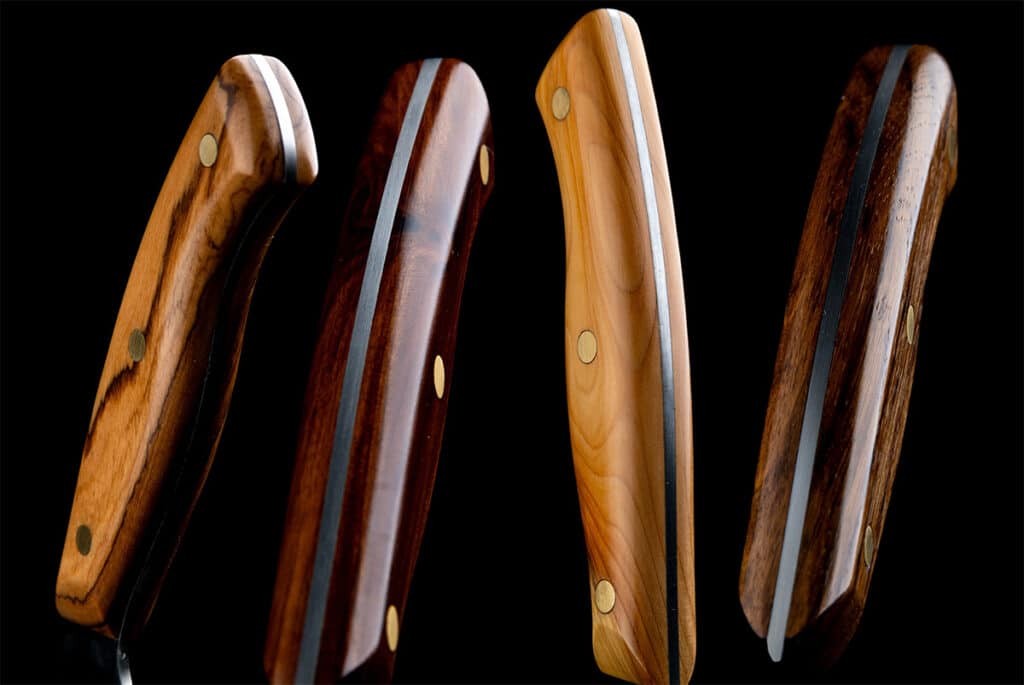
Wood Handle maintenance.
We never use varnish or other highly synthetic coatings on our handles – if nothing else, we’ve never found one that lasts more than a few months in a demanding kitchen before starting to chip and degrade.
Instead, all of our handles are treated extensively with high-quality Danish Oil and then lightly buffed with wax before being posted.
Over time the buffed wax layer will fade away (but gradually and more evenly than a varnish) and thereafter we recommend re-oiling your handles every month or so, or when they start to look like they would benefit from some love:
Wash and dry your handle (and if you like you can gently sand all over with P600 sandpaper). Then apply – with a lint-free cloth – a good coating of Danish Oil. Adding terebene at around 10-20% will increase penetration and speed up drying time.
Leave the handle for 5 minutes, wipe off the excess and leave for a further hour. Repeat once (or twice if the handle is thirsty) and then ideally leave somewhere warm for 24 hours, or at the very least until thoroughly dry to the touch.
All wooden handles will benefit from continual use.
The dishwasher is a knife’s mortal enemy
The single most important thing to remember is NEVER to put it in the dishwasher. It will not enjoy being sprayed with salty detergent and being heated to 80ºc!
In the event of a guest (or someone else trying to be helpful) putting your knife through the dishwasher, we offer a handle replacement and blade re-conditioning service for £50 + p&p.
As the knives adapt to the heat and humidity of your kitchen, there may be a very slight expansion or contraction of the handle material. This will be most noticeable in a natural wood handle, less so in a stabilised handle and almost imperceptible with Richlite or similar materials.
The expansion will be most noticeable around the area of the pins. If you like, you can use some 400 or 600 grit sandpaper to smooth the handle down.
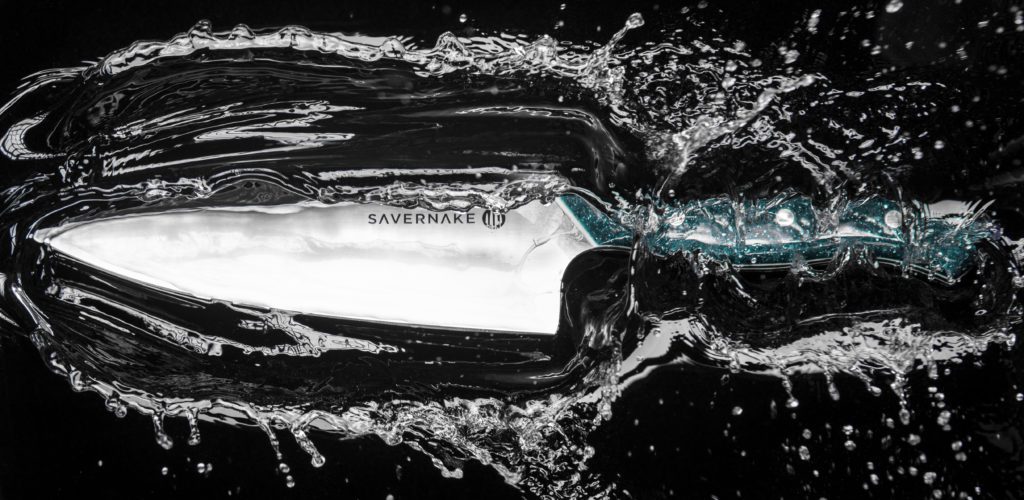
A few words on engraving
Any engraving on the blade is a two-part process. The main cut removes around 1/20th of a millimetre of steel, with a secondary black finish applied as the top few microns of the steel are annealed.
The deep engraving will last the lifetime of the knife, whereas the black will very, very slowly fade over time as you clean the blade, and hence we recommend not using too much elbow grease (or too abrasive a cleaning agent) on any engraving as you’ may hasten its demise.
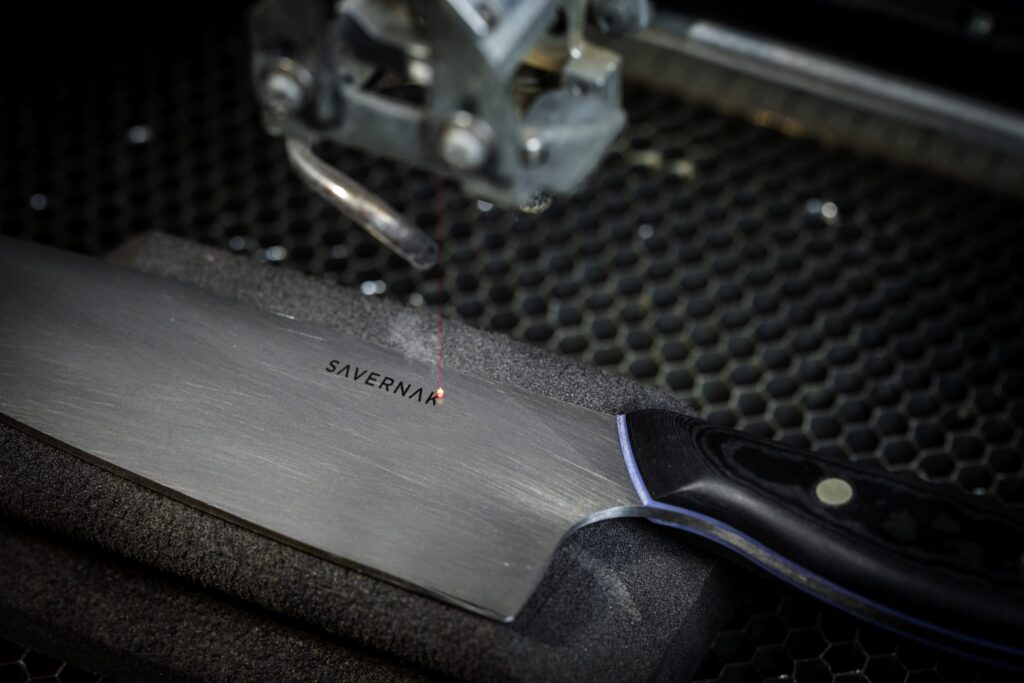
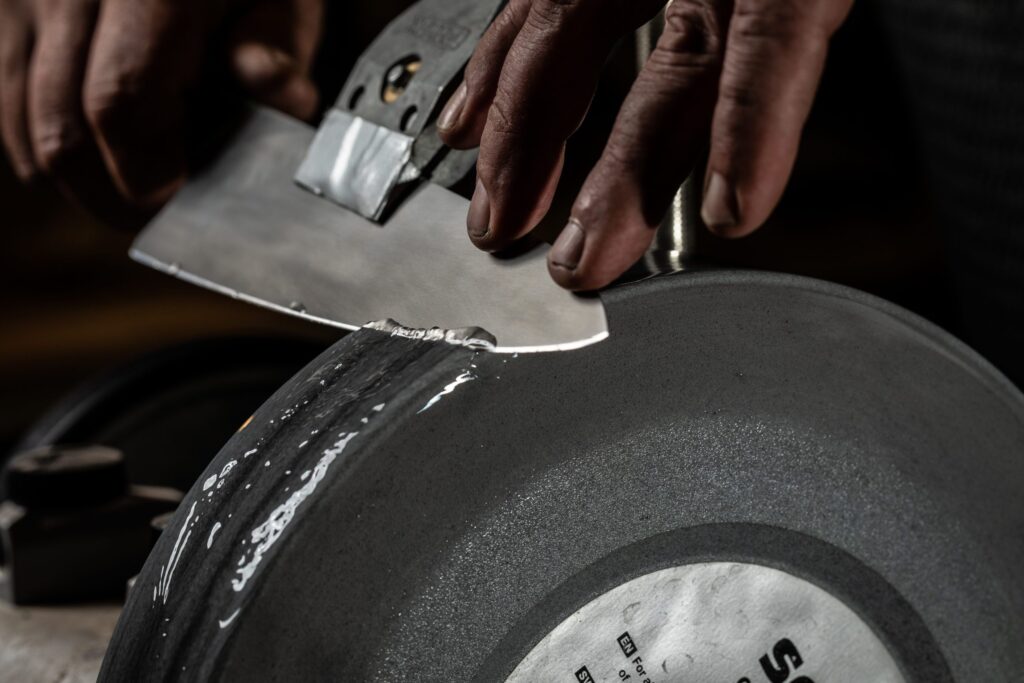
How to sharpen your knife
The best way to look after your knife is to hone it every time you use it, thereby having to sharpen only occasionally. Our knives are made to be as hard as possible while still being able to take a good honing.
Understanding the difference between honing and sharpening is the single most important thing you can learn (as regards caring for a knife). A good honing steel, such as our own range (with the ability to match the handle to your knife) is vital, and you should use it gently every time you cook, if possible – see here.
We currently recommend HORL 3 Sharpeners, but if you’d like some other recommendations then do get in touch, or even if you just want some tips on how to use your HORL most effectively.
Repair service
We offer a complimentary sharpening and edge retention service once a year for the first 3 years after buying your new knife. Details are included with any purchase, but we will of course always be prepared to repair a damaged knife, be that a chipped edge from slamming through a pig carcass or from a helpful house guest putting your blade through the dreaded dishwasher.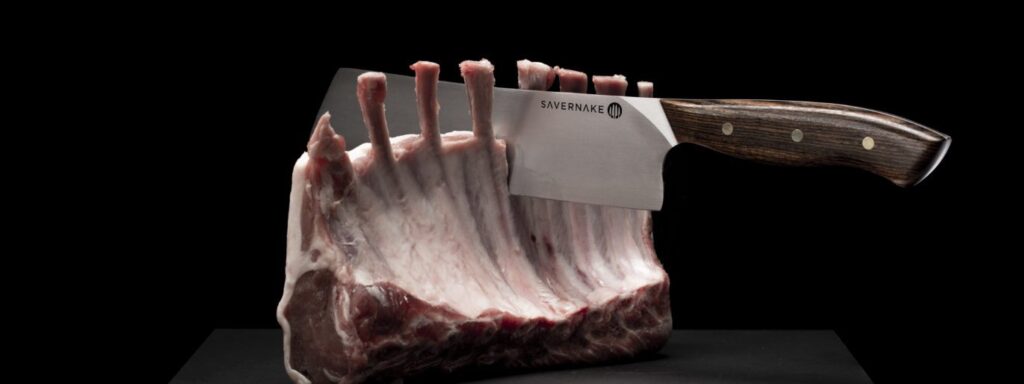
I must say I was nervous buying a knife without even holding it but glad I took the gamble.”
DANIEL PEARCE, BUTCHER – JULY 2020
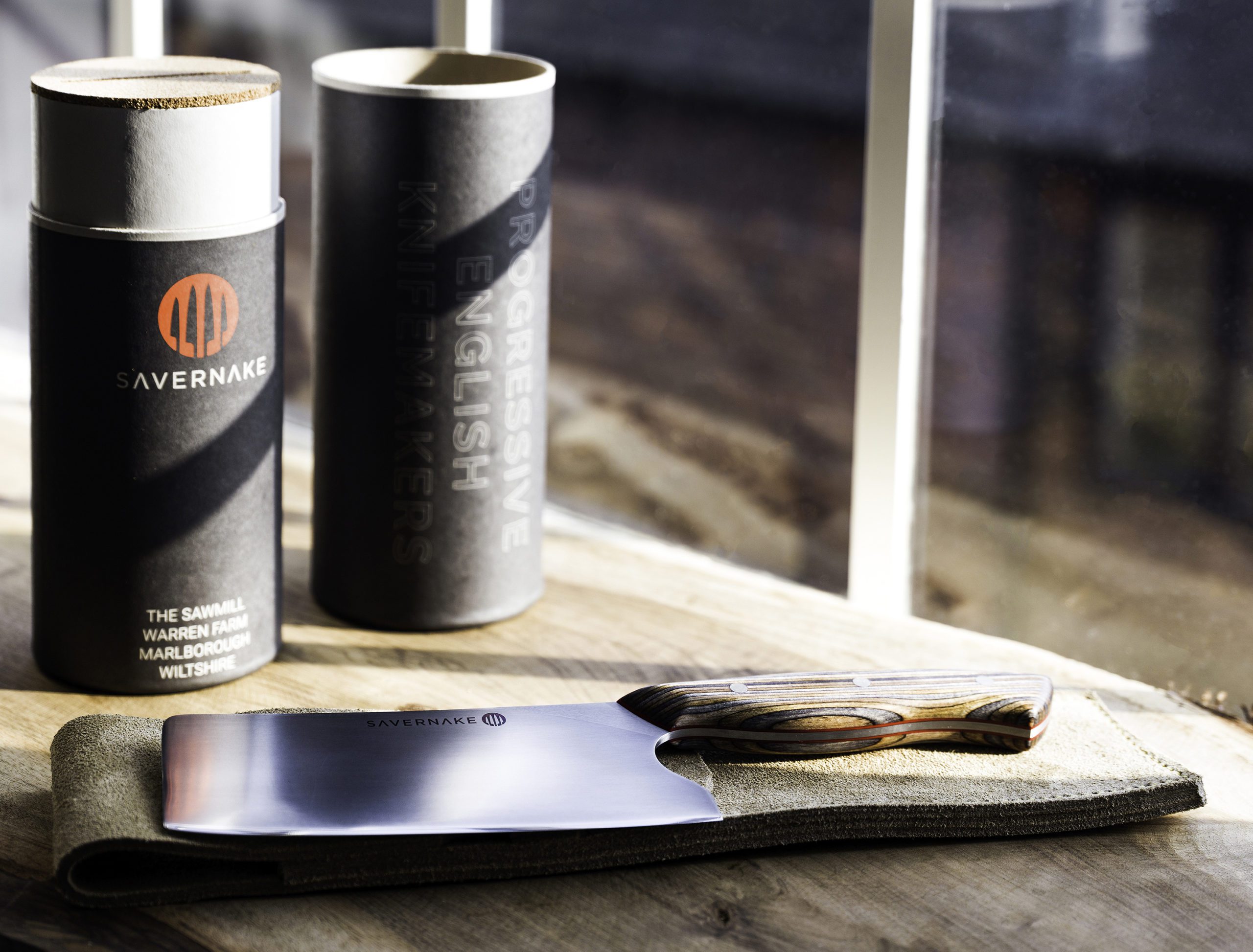
A Lifetime of Creativity
Your Savernake knife will respond beautifully to the frequent, gentle touches of a honing steel. Properly cared for, it will need sharpening very infrequently – which, of course, we can do for you. Treat your Savernake knife well and it will last a lifetime and beyond.
Complimentary Engraving
Personalised engraving is included on all knives

lifetime guarantee
With proper care, our knives are guaranteed for a lifetime of use

international delivery
Delivery to UK included, flat rate shipping worldwide
DISCOVER OUR KNIVES
Whether you’re searching for your perfect knife, or on the elusive hunt for a gift for a hard-to-buy for relative or friend – choose from our range of personalised custom knives, bespoke or custom knife gift invitations, special edition or ready made knives and accessories.
KNIFE CARE & SHARPENING FAQs Top
For questions regarding the what we mean by the various parts of a knife and how to care for our knives.
HOW SHOULD I CARE FOR MY SAVERNAKE KNIFE?
If you care for your knife it will give you a lifetime of service.
The single most important thing to remember is NEVER to put it in the dishwasher. It will not enjoy being sprayed with salty detergent and being heated to 80ºc!
In the event of a guest (or someone else trying to be helpful) putting your knife through the dishwasher, we offer a handle replacement and blade re-conditioning service for £50 + p&p.
As the knives adapt to the heat and humidity of your kitchen, there may be a very slight expansion or contraction of the handle material. This will be most noticeable in a natural wood handle, less so in a stabilised handle and almost imperceptible with Richlite or similar materials.
The expansion will be most noticeable around the area of the pins. If you like, you can use some 400 or 600 grit sandpaper to smooth the handle down.
Natural wood handles would benefit from occasional oiling (we prefer Danish Oil). Make sure the handle is clean and dry and apply a good coating of the oil, leave for 5 mins and wipe off any excess before leaving the knife overnight for the oil to settle and cure. If you usually store your knife in a leather wrap, leave it to dry for 24 hours before returning it the wrap to avoid any staining or product transfer.
The kitchen is arguable the most demanding of locations for a knife handle (all that salt, fat, water, detergent, oil, heat, humidity etc) and so as long as you’re prepared to care for the handle and keep on top of it, you’re golden. If that fills you with fear, then we have plenty of other low-maintenance options.
All of our other handles have a very light layer of wax applied when they leave us, and if you’d ever like to restore a bit of lustre then a thorough rubbing with some beeswax polish will see you right.
All handles will benefit from regular use.
Any engraving on the blade is a two-part process. The main cut removes around 1/20th of a millimetre of steel, with a secondary black finish applied as the top few microns of the steel are annealed. The deep engraving will last the lifetime of the knife, whereas the black will very, very slowly fade over time as you clean the blade, and hence we recommend not using too much elbow grease (or too abrasive a cleaning agent) on any engraving as you’ may hasten its demise.
HOW SHOULD I SHARPEN MY SAVERNAKE KNIFE?
The best way to look after your knife is to hone it every time you use it, thereby having to sharpen only occasionally. Our knives are made to be as hard as possible while still being able to take a good honing.
Understanding the difference between honing and sharpening is the single most important thing you can learn (as regards caring for a knife). A good honing steel, such as our own range (with the ability to match the handle to your knife) is vital, and you should use it gently every time you cook, if possible – see here.
WHAT’S THE DIFFERENCE BETWEEN SHARPENING AND HONING AND HOW REGULARLY SHOULD I BE DOING IT?
Honing requires a decent honing rod and serves to reshape the very edge of a blade after it becomes misaligned through frequent and inconsistent contact with a chopping board. A professional chef will do this every time they cook. Far from the fast-paced, slashing technique that we often see on television (we’re looking at you Mr Ramsey), this should be done slowly and methodically. The key is to maintain the same angle, or as close as is humanly possible, as you slide the blade’s edge along the rod, alternating sides as you do so. The perfect angle will be dictated by the angle of the initial bevel made by the maker of the knife, but generally speaking, a chef’s knife will be somewhere between 12-17 degrees.
Regular honing will delay the need for sharpening, two terms which are often thought to mean the same thing. Sharpening will generally need to be done a couple of times a year, with a whetstone being the most effective method. This is a slightly more involved process with numerous online videos and tutorials showing how it’s done properly.
CAN YOU RECOMMEND THE BEST SHARPENING METHOD?
Until recently, we were of the opinion that the many ‘quick-fire’ sharpening devices out there are like hangover cures – if they actually worked then we’d all have one. At the moment, our preferred domestic option is the Lansky Master’s Edge – it won’t put a new edge on a very old or knackered knife, but if you use it on one of our blades as soon as you notice the honing steel isn’t getting the edge up to snuff, then you’ll be set for life.
If you prefer whetstone, we suggest you watch this chap on YouTube as we find him to be the least full of rubbish and pleasingly lugubrious – he will recommend you go to a very fine grit, but we think that anything above 1 thousand is excessive for kitchen use. In fact beyond this will create a weaker edge (only after considerable effort) that won’t perceptibly improve cutting performance.
This whetstone will be great to start off with, and at only £20 it doesn’t matter if you take a few bits out of it while getting the hang of things. If you find you want to go up a level (that one being 400/1000 grit) then this one will get it ridiculously sharp.
The last step in sharpening is removing the burr – the hide side of an old leather belt will do, or buy a strop such as this one. A bit of baby oil on the leather will help you get a nice, even covering of the polishing compound.
As with most things, you get what you pay for. The stones above will do you well to start – and not be too expensive if you make a mistake – but ultimately better stones with give you a better edge. Our preferred brand is Naniwa.
We very highly recommend this sink brace – it allows you to put the knife securely on a sink and keep a trickle of water flowing. It assists in achieving a zen-like calm while sharpening.
If you’re of the ‘kit’ persuasion, then we suggest the Edge Pro.
And if this all sounds far too much like hard work? Then just post your knives back to us and we’ll do it all for you.
HELP! I’VE HACKED MY WAY THROUGH A RECALCITRANT LEG OF LAMB, WHAT SHOULD I DO?
We offer a complimentary sharpening and edge retention service once a year for the first 3 years after buying your new knife. Details are included with any purchase, but we will of course always be prepared to repair a damaged knife, be that a chipped edge from slamming through a pig carcass or from a helpful house guest putting your blade through the dreaded dishwasher.
Discover more about Savernake Knives via our FAQs.
